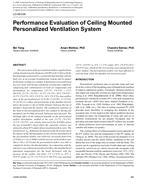
LO-09-036 — Performance Evaluation of Ceiling Mounted Personalized Ventilation System
- Comments Off on LO-09-036 — Performance Evaluation of Ceiling Mounted Personalized Ventilation System
- ASHRAE
The interaction of the personalized airflow supplied from ceiling mounted nozzle (diameter of 0.095 m (0.312ft)) with the thermal plume generated by a seated thermal manikin with the body size of an average Scandinavian woman and its impact on the body cooling was studied. Experiments were performed in a test room with mixing ventilation at numerous conditions comprising four combinations of room air temperature and personalized air temperature (23.5°C (74.3°F) / 21°C (69.8°F), 23.5°C (74.3°F) / 23.5°C (74.3°F), 26°C (78.8°F) / 23.5°C (74.3°F), 26°C (78.8°F) / 26°C (78.8°F)), four airflow rates of the personalized air (4 (8.48), 8 (16.95), 12 (25.43), 16 (33.91) L/s (cfm)) and positioning of the manikin directly below the nozzle (1.3m (4.265ft) distance between the top of manikin’s head and the nozzle). The asymmetric exposure of the body to the personalized flow was studied by moving the manikin 0.2m (0.656ft) forward, backward and sideward. The blockage effect of the unheated manikin on the personalized airflow distribution, studied at the case 23.5°C (74.3°F)/23.5°C (74.3°F), was clearly observed 0.2m (0.656ft) above the top of manikin’s head where the centerline velocity was reduced to about 85% under all personalized airflow rates. The neutral level, Xnl, defined as the distance from the nozzle where the impact of the thermal plume on the velocity distribution in the personalized airflow was observed, increased from 0.8m (2.625ft) to 1.1m (3.609ft) with the increase of the airflow rate. Above 16L/s (33.91cfm) the personalized airflow was able to completely destroy the thermal plume. In comparison with the reference case without personalized airflow, the manikin based equivalent temperature for the head decreased with the increase of the airflow rate from -1°C (-1.8°F) to -6°C (-10.8°F) under 23.5°C (74.3°F)/21°C (69.8°F) case and from -0.5°C (-0.9°F) to -4°C (-7.2°F) under 26°C (78.8°F)/26°C (78.8°F) case, which are the two extreme cases among the four cases studied. The personalized airflow was least efficient to cool the body when the manikin was moved forward.
Units: Dual
Citation: ASHRAE Transactions, vol. 115, pt. 2, Louisville 2009
Product Details
- Published:
- 2009
- Number of Pages:
- 12
- File Size:
- 1 file , 850 KB
- Product Code(s):
- D-LO-09-036

